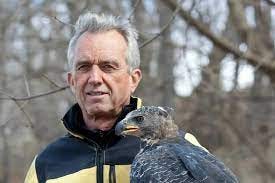This November, Robert F. Kennedy Jr. will teach the art of falconry at an event supporting Children’s Health Defense.
Falconry is an ancient art and sport that involves training birds of prey, such as falcons or hawks, to hunt in cooperation with a human falconer.
You can read more about the November event, here.
Kennedy’s passion for falconry reflects his deep commitment to nature, conservation, and the inherent value of forging a harmonious relationship between humanity and the natural world.
For Kennedy, falconry is a source of personal growth, a way to connect with the natural world, and a means to gain insights into the behavior of raptors. He has spoken about how falconry has allowed him to witness the incredible hunting abilities of these birds up close, fostering a sense of wonder and respect for the environment.
Outside its recreational rewards, Kennedy's passion for falconry is intertwined with his broader advocacy for environmental conservation and animal rights. He has used his platform to raise awareness about the importance of preserving wildlife habitats, protecting endangered species, and addressing environmental issues. Falconry, to him, embodies the harmony between humans and nature and serves as a reminder of the delicate balance that needs to be maintained for the well-being of both. In these regards, he carries the torch from his father and uncle—both were also proponents of conservation and environmental protection.
In his book, American Values: Lessons I Learned from My Family, Kennedy writes about how nature and animals were part of his daily life as a child in their home in Hickory Hill, Virginia. The family moved there from Georgetown when Kennedy was three.
At eleven, Kennedy’s passion for birds found a distinct focus. After reading T. H. White’s, The Once and Future King, about King Arthur, Kennedy bought every book available on falconry. He grew captivated by this ancient practice of training wild hawks for hunting.
“I followed the exploits of the Craigheads, a family of outdoorsmen and falconers, in National Geographic,” he writes. “I wrote Jean Craighead George, when she published her best-seller My Side of the Mountain, asking her how best to find a kestrel nest…Whenever I visited the Justice Department or the White House, I’d look for eastern anatum peregrine falcons, who for decades nested on the cupola of the old post office in Washington, D.C.”
He continues, “When I nearly severed my foot in a 1965 accident that kept me on crutches for months, my father bought me a pet-store red-tailed hawk, as consolation. I named her Morgan, after King Arthur’s half sister.”
The turning point in Kennedy's falconry journey came when he found a local falconer, Alva Nye, who lived near Hickory Hill. An aviation engineer employed by the Pentagon and a pioneer of falconry in America, Nye became his mentor. “My father knew of Nye because the State Department occasionally asked him to entertain visiting Arab dignitaries, many of whom were crazy for hawks,” Kennedy writes.
Kennedy's pursuit of falconry was also informed by Emperor Frederick II's manual, which detailed the qualities necessary to become a falconer. “He must be nimble and strong, able on horseback and know the habits and habitat of each hawk and its quarry. . . . He must possess a retentive memory, and be impervious to hunger, heat, and cold.”
These traits became a guiding philosophy for Kennedy's life.
A lifelong passion
Growing up in Hickory Hill, Kennedy and his brothers engaged in a series of activities to mold themselves into skilled falconers, including constructing obstacle courses, climbing ropes, riding horses, learning bird calls, and more. Their pursuits included trapping vultures and red-tailed hawks and capturing pigeons for trapping hawks, all in alignment with their falconry ambitions.
In the fall of 1968, following his father’s death, Kennedy entered ninth grade at Millbrook School in New York’s Hudson Valley. “I recall Millbrook as a happy, and occasionally idyllic, place,” he writes. “I chose the school because it operated a certified zoo and several of the boys practiced falconry. We spent every free moment climbing trees, trapping and training wild hawks, fashioning tack out of leather, and hunting with our hawks in the forests and farm fields surrounding the school. It wasn’t all fun; I was regularly in fist fights at Millbrook.”
At Millbrook, while many other students enjoyed extracurricular activities such as art and theater, Kennedy spent time with students who also enjoyed falconry. “We talked about hawks every spare moment—at meals, between classes, and after chapel,” Kennedy recalls in Dick Russell’s book, The Real RFK. Jr. – Trials of a Truth Warrior.
Kennedy’s life at Millbrook was not easy; he struggled with the death of his father and uncle. Falconry gave him an escape. “The falconry gave a gravity to my life that was not destructive, and everything else happening was,” Kennedy tells Russell.
Early on, Kennedy aspired to become a veterinarian or a scientist. Eventually, he elected to carry forward his family's legacy of public service and environmental advocacy, interwoven with an enduring passion for falconry.






💕🦅Love these personal, developmental stories! ☀️
The Arthurian knights! Galahad, Perceval, Gawain and all the others. Each of them / us joining to fight evil. Then, in the stories and now, in times when it seemed that we were going to loose the final battle.
Don't know how but it seems that most of mankind could feel the seriousness of the loss of the two great knights named John F. Kennedy and Robert Kennedy. (Even here in Holland, everybody older than 66/67 remembers where he or she was at the moment of the assassination of JFK.) Today, for most people, the moral sense with which they felt this seriousness must still exist. I hope that in the coming months a lot of people will come to recognize RFKjr. as a great Arthurian knight and join the fight. Thank you to the Kennedy Beacon team for contributing to greater awareness of RFK Jr.!